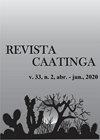Gas exchange, growth, and production of cotton genotypes under water deficit in phenological stages
IF 0.9
4区 农林科学
Q3 AGRONOMY
引用次数: 6
Abstract
ABSTRACT Cotton cultivation in the Brazilian Northeast region faces water scarcity problems caused by the irregularity of the rainy season, leading to losses in yield. In this context, the objective of the present study was to evaluate the gas exchange, growth, and production of colored-fiber cotton genotypes under water stress, varying the water deficit management strategies in the different phenological stages of the plant. The study was carried out in the experimental area of the Federal University of Campina Grande, located in the municipality of Pombal, Paraíba, Brazil. A randomized block design was used, in a 3 × 7 factorial scheme, corresponding to three colored cotton genotypes (‘BRS Rubi’, ‘BRS Jade’, and ‘BRS Safira’) and application of water deficit (40% of actual evapotranspiration - ETr) management strategies in seven phenological stages of the crop. The ‘BRS Jade’ genotype is the most suitable for cultivation under water deficit conditions with 40% of the actual evapotranspiration. Colored-fiber cotton cultivation under water deficit in the flowering stage caused a reduction in physiological variables and growth. Water deficit during the vegetative and yield formation stages promoted lower losses in the production of seed cotton and total seed weight of the genotypes ‘BRS Rubi’, ‘BRS Jade’, and ‘BRS Safira’.缺水条件下棉花基因型在酚期的气体交换、生长和产量
由于雨季不规律,巴西东北地区棉花种植面临缺水问题,导致产量损失。在此背景下,本研究的目的是评估水分胁迫下彩色纤维棉基因型的气体交换、生长和生产,以及在植物不同物候阶段不同的水分亏缺管理策略。这项研究是在位于巴西庞巴尔市Paraíba的坎皮纳格兰德联邦大学实验区进行的。采用随机区组设计,采用3 × 7因子方案,对应3种彩色棉花基因型(BRS Rubi、BRS Jade和BRS Safira)和作物7个物候阶段水分亏缺(实际蒸散量的40%)管理策略。BRS Jade基因型最适合在实际蒸散量40%的亏水条件下栽培。花期水分亏缺条件下的彩棉栽培,导致彩棉的生理指标下降,影响其生长。营养和产量形成阶段的水分亏缺促进了“BRS Rubi”、“BRS Jade”和“BRS Safira”基因型籽棉生产损失和总种子重降低。
本文章由计算机程序翻译,如有差异,请以英文原文为准。
求助全文
约1分钟内获得全文
求助全文
来源期刊

Revista Caatinga
AGRONOMY-
CiteScore
2.10
自引率
11.10%
发文量
67
审稿时长
6-12 weeks
期刊介绍:
A Revista Caatinga é uma publicação científica que apresenta periodicidade trimestral, publicada pela Pró-Reitoria de Pesquisa e Pós-Graduação da Universidade Federal Rural do Semi-Árido – UFERSA, desde 1976.
Objetiva proporcionar à comunidade científica, publicações de alto nível nas áreas de Ciências Agrárias e Recursos Naturais, disponibilizando, integral e gratuitamente, resultados relevantes das pesquisas publicadas.
 求助内容:
求助内容: 应助结果提醒方式:
应助结果提醒方式:


